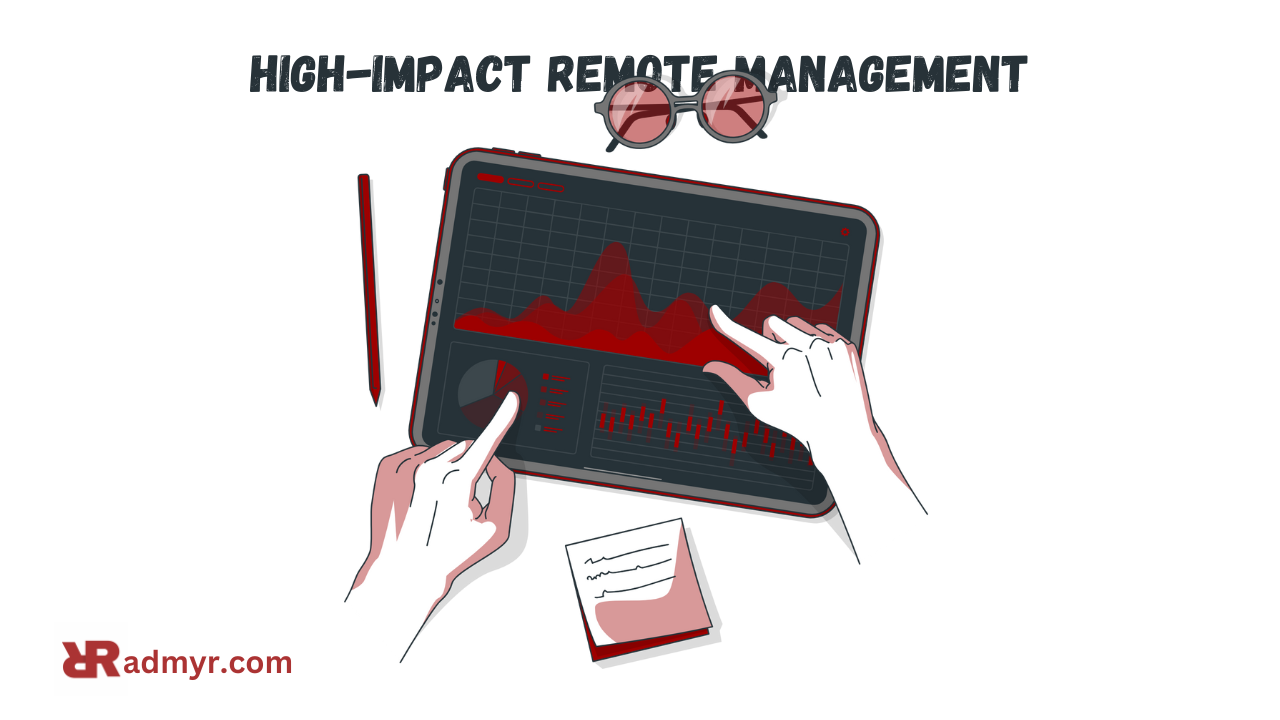Your cart is currently empty!
High-Impact Remote Management: Strategies for Leading Virtual Teams Effectively

As remote work becomes increasingly common, high-impact remote management is essential for businesses striving to maintain productivity and team cohesion. Effective leadership in a virtual environment requires strategic communication, trust-building, and the right technological tools. This guide explores the best practices for managing remote teams while ensuring engagement, efficiency, and long-term success.
The Key Challenges of Remote Management
Remote managers face unique obstacles that can impact performance and team dynamics. Addressing these challenges is the first step toward high-impact remote leadership.
1. Communication Barriers
Without face-to-face interactions, miscommunication can occur more frequently, leading to misunderstandings and project delays. Employees may struggle with interpreting tone in emails or chat messages, causing unnecessary confusion.
2. Lack of Engagement
Remote employees may feel disconnected from the company culture, leading to lower motivation and productivity. Without physical interaction, employees might not feel part of a larger team, potentially reducing job satisfaction.
3. Performance Monitoring
Tracking team performance and ensuring accountability can be difficult without direct supervision. Managers must strike a balance between trust and oversight, avoiding micromanagement while still ensuring productivity.
4. Time Zone Differences
For global teams, scheduling meetings and maintaining collaboration across different time zones is a challenge. Coordinating real-time discussions can be difficult, leading to delays in decision-making and execution.
5. Maintaining Productivity and Work-Life Balance
Remote workers often struggle with separating work from personal life, leading to burnout or distractions that lower efficiency. Ensuring employees stay productive while maintaining well-being is crucial.
Strategies for High-Impact Remote Management
1. Establish Clear Communication Channels
To overcome communication challenges, remote leaders must adopt structured and effective channels:
- Daily Check-Ins: Schedule brief morning meetings to align tasks and goals.
- Slack, Microsoft Teams, or Zoom: Use instant messaging and video calls for real-time collaboration.
- Asynchronous Updates: Encourage written updates for better transparency and record-keeping.
- Standardized Communication Practices: Implement clear guidelines on response times and preferred channels for different types of communication.
2. Set Expectations and Define Goals Clearly
A well-structured remote team needs clearly defined goals and performance expectations:
- Use the SMART Goals Framework (Specific, Measurable, Achievable, Relevant, Time-bound).
- Outline KPIs (Key Performance Indicators) to measure productivity and success.
- Provide clear project deadlines and responsibilities for accountability.
- Set weekly and monthly goals to track performance progress.
3. Foster a Strong Remote Work Culture
Building a positive virtual work culture helps retain top talent and enhances collaboration.
- Virtual Team-Building Activities: Organize online coffee chats, game sessions, or happy hours.
- Employee Recognition Programs: Celebrate achievements to boost morale and engagement.
- Encourage Work-Life Balance: Promote healthy schedules to prevent burnout.
- Organize Regular Leadership Q&A Sessions: Keep employees informed and engaged with transparent discussions.
4. Leverage the Right Remote Work Tools
Using productivity-enhancing tools helps streamline operations and improve efficiency:
- Project Management: Trello, Asana, Monday.com for task tracking.
- Collaboration: Google Drive, Notion, and Confluence for document sharing.
- Time Management: Toggl, Clockify, or RescueTime for tracking work hours.
- Cybersecurity: VPNs and encrypted communication platforms for data protection.
- Automated Workflow Tools: Implement Zapier or Automate.io to reduce repetitive tasks.
5. Prioritize Employee Well-Being and Mental Health
A happy and motivated team leads to increased productivity and engagement.
- Regular Check-Ins: Schedule one-on-one meetings to address concerns and provide feedback.
- Encourage Flexibility: Allow employees to manage their schedules to maximize productivity.
- Provide Wellness Resources: Offer virtual fitness classes, mental health webinars, or meditation apps.
- Implement Employee Assistance Programs (EAPs): Provide counseling services to help employees cope with stress.
6. Implement an Effective Performance Evaluation System
Tracking remote employees’ progress requires a structured performance management strategy:
- Set weekly and monthly reports to track project progress.
- Use 360-degree feedback mechanisms to encourage constructive peer reviews.
- Recognize top performers through incentives and rewards.
- Adopt OKRs (Objectives and Key Results): Ensure alignment with company-wide goals.
- Schedule Quarterly Performance Reviews: Provide structured growth feedback.
7. Optimize Remote Onboarding and Training
A seamless onboarding experience ensures that new hires integrate smoothly into remote teams:
- Develop a structured onboarding program with training materials and virtual mentorship.
- Assign buddies or mentors to guide new employees.
- Use pre-recorded video tutorials for training sessions.
- Offer Ongoing Learning Opportunities: Provide online courses for continuous skill development.
- Create an Onboarding Checklist: Ensure all necessary tools, accounts, and resources are provided from day one.
The Future of Remote Work and Leadership Trends
The remote work landscape is continuously evolving, and future trends will shape how businesses manage virtual teams:
- Hybrid Work Models: A combination of remote and in-office work for increased flexibility.
- AI and Automation: Implementing AI-powered virtual assistants for routine tasks.
- Augmented Reality (AR) Meetings: Virtual reality solutions for immersive team interactions.
- Global Talent Pools: Expanding hiring strategies to access top talent worldwide.
- Increased Focus on Asynchronous Work: Reducing reliance on real-time communication to improve efficiency.
- Advanced Employee Monitoring Tools: Ethical tracking solutions to enhance performance analysis.
Conclusion
High-impact remote management is about effective communication, cultural cohesion, and leveraging technology to ensure productivity. By implementing these strategies, businesses can successfully lead remote teams, improve performance, and adapt to the changing workforce landscape. As remote work continues to evolve, embracing new tools and approaches will be key to long-term success.
Leave a Reply